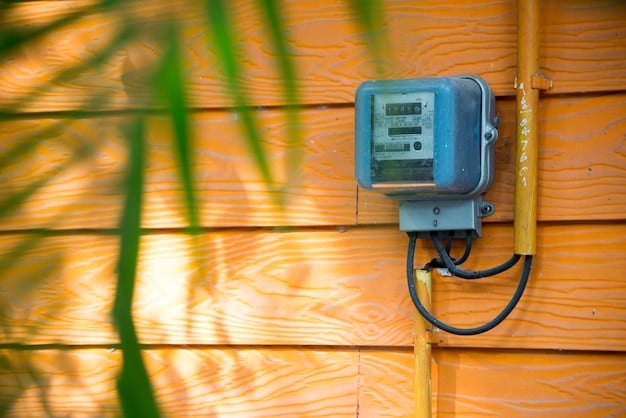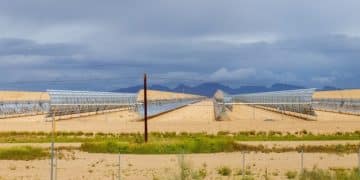Latest US Smart Grid Advancements: Revolutionizing Energy Distribution

The latest advancements in US smart grid technology for improved energy distribution include enhanced data analytics, advanced metering infrastructure (AMI), cybersecurity measures, integration of renewable energy sources, and deployment of energy storage systems.
Are you curious about how the US is revolutionizing its energy distribution? The **latest advancements in US smart grid technology for improved energy distribution** are transforming the way we power our lives and businesses, paving the way for a more efficient and sustainable future.
Understanding the Smart Grid Evolution in the US
The smart grid represents a significant upgrade from the traditional electrical grid, incorporating digital technology to enhance efficiency, reliability, and sustainability. Understanding its evolution is crucial to appreciating the latest advancements transforming energy distribution in the US.
Initially, the electrical grid was a one-way system, delivering power from central power plants to consumers. The smart grid, however, integrates two-way communication, allowing for real-time monitoring and control. This shift enables better management of energy resources and quicker response to grid disturbances.

Key Components of a Smart Grid
Several components work together to create a functional smart grid. Advanced Metering Infrastructure (AMI), smart meters, and communication networks are essential pieces that facilitate real-time data exchange.
- Smart Meters: These devices record energy consumption in detail and transmit data to utilities, providing accurate usage information for billing and grid management.
- Communication Networks: These networks enable data transfer between smart meters, grid sensors, and control centers, allowing for real-time monitoring and control.
- Sensors and Monitoring Devices: Deployed throughout the grid, these devices collect data on voltage, current, temperature, and other parameters, providing a comprehensive view of grid conditions.
Furthermore, integrating renewable energy sources such as solar and wind power requires advanced grid management capabilities. The smart grid facilitates this by balancing supply and demand, ensuring a stable and reliable power supply.
In conclusion, the evolution of the smart grid in the US marks a significant shift towards a more dynamic and responsive energy infrastructure. By incorporating advanced technologies, the smart grid paves the way for improved energy distribution, reduced costs, and a more sustainable energy future.
Enhanced Data Analytics for Grid Optimization
Data analytics plays a critical role in optimizing the performance of smart grids. By collecting and analyzing vast amounts of data, utilities can gain insights into grid operations, improve efficiency, and enhance reliability. Let’s explore how enhanced data analytics is transforming energy distribution in the US.
Advanced data analytics tools enable utilities to monitor grid conditions in real-time, identify potential problems, and take corrective actions before they escalate. This proactive approach helps prevent outages, reduce downtime, and improve overall grid performance.
Predictive Analytics in Smart Grids
Predictive analytics uses historical data and advanced algorithms to forecast future grid conditions. This capability allows utilities to anticipate demand fluctuations, plan maintenance activities, and optimize resource allocation.
By predicting energy demand, utilities can more effectively manage generation and distribution, ensuring a stable and reliable power supply. Predictive maintenance helps identify equipment failures before they occur, reducing the risk of outages and extending the lifespan of grid assets.
- Demand Forecasting: Utilities can predict energy consumption patterns based on historical data, weather forecasts, and other factors.
- Predictive Maintenance: Algorithms analyze equipment data to identify potential failures and schedule maintenance proactively.
- Resource Optimization: Data analytics helps allocate resources efficiently, ensuring optimal grid performance.
Moreover, data analytics contributes to enhanced grid security by detecting and mitigating cyber threats. By monitoring network traffic and system logs, utilities can identify suspicious activities and respond quickly to prevent attacks.
In summary, enhanced data analytics is a game-changer for smart grid optimization. By leveraging data-driven insights, utilities can improve efficiency, enhance reliability, and secure the grid against potential threats, driving the evolution of energy distribution in the US.
Advanced Metering Infrastructure (AMI) and Smart Meters
Advanced Metering Infrastructure (AMI) and smart meters are vital components of modern smart grids. These technologies provide detailed, real-time data on energy consumption, enabling both utilities and consumers to make informed decisions. Let’s delve into the specifics of AMI and smart meters and their impact on energy distribution.
AMI systems consist of smart meters, communication networks, and data management systems that work together to provide advanced metering functionalities. Smart meters record energy consumption at short intervals and transmit this data to utilities.
Benefits of AMI and Smart Meters
The implementation of AMI and smart meters brings a multitude of benefits. These include improved billing accuracy, enhanced grid management, and increased consumer engagement.
AMI enables utilities to detect and respond to outages more quickly, improving grid reliability. Smart meters empower consumers to monitor their energy usage and make adjustments to reduce their bills.
- Real-Time Data: Smart meters provide real-time data on energy consumption, allowing for better monitoring and management.
- Remote Monitoring: Utilities can remotely monitor and manage smart meters, reducing the need for on-site visits.
- Demand Response: AMI enables demand response programs, incentivizing consumers to reduce energy consumption during peak periods.
Furthermore, AMI supports the integration of distributed generation sources, such as solar panels, into the grid. By providing detailed data on energy production and consumption, AMI helps balance supply and demand, ensuring grid stability.

In conclusion, Advanced Metering Infrastructure and smart meters are cornerstones of the smart grid, providing the data and functionalities needed to optimize energy distribution. By leveraging these technologies, utilities can improve efficiency, enhance reliability, and empower consumers to take control of their energy usage.
Cybersecurity Measures for Smart Grid Protection
As smart grids become increasingly reliant on digital technology, cybersecurity becomes paramount. Protecting the grid from cyber threats is essential to ensure a reliable and secure energy supply. Let’s explore the cybersecurity measures being implemented to safeguard US smart grids.
Smart grids are vulnerable to a range of cyber threats, including malware attacks, denial-of-service attacks, and data breaches. These attacks can disrupt grid operations, compromise sensitive data, and cause widespread outages.
Strategies for Enhancing Cybersecurity
Several strategies are being employed to enhance the cybersecurity of smart grids. These include implementing robust security protocols, conducting regular security audits, and providing cybersecurity training to personnel.
Encryption is used to protect sensitive data transmitted over communication networks. Intrusion detection systems monitor network traffic and system logs for suspicious activities, providing early warning of potential attacks.
- Encryption Protocols: Encrypting data ensures it cannot be intercepted and read by unauthorized parties.
- Intrusion Detection Systems: These systems monitor network traffic and system logs for suspicious activities.
- Access Controls: Limiting access to sensitive systems and data helps prevent unauthorized access and data breaches.
Moreover, collaboration between utilities, government agencies, and cybersecurity experts is crucial for sharing threat intelligence and coordinating responses to cyber incidents. Regular security audits and penetration testing help identify vulnerabilities and ensure that security measures are effective.
In summary,robust cybersecurity measures are essential for protecting US smart grids from cyber threats. By implementing these strategies, utilities can mitigate risks, ensure grid reliability, and safeguard sensitive data, furthering the advancement of secure energy distribution.
Integrating Renewable Energy Sources into the Smart Grid
The integration of renewable energy sources such as solar and wind power is a key goal of smart grid technology. However, integrating these intermittent sources poses unique challenges. Let’s examine how smart grids are adapting to incorporate renewable energy effectively.
Renewable energy sources are inherently variable, depending on weather conditions and time of day. This variability can create imbalances in the grid, leading to instability and potential outages.
Techniques for Managing Renewable Energy Integration
Several techniques are used to manage the integration of renewable energy into the grid. These include advanced forecasting, energy storage, and demand response programs.
Advanced forecasting helps predict the output of renewable energy sources, allowing utilities to plan accordingly. Energy storage systems, such as batteries, can store excess energy generated during periods of high renewable output and release it when demand is high.
- Advanced Forecasting: Predicting the output of renewable energy sources helps utilities plan and manage grid operations.
- Energy Storage: Batteries and other energy storage systems can store excess energy and release it when needed.
- Demand Response: Programs incentivize consumers to adjust their energy consumption to match renewable energy availability.
Furthermore, smart grids facilitate the integration of distributed generation sources, such as rooftop solar panels, by providing real-time data on energy production and consumption. This enables utilities to manage the flow of electricity more effectively, ensuring grid stability.
In conclusion, the smart grid plays a critical role in enabling the integration of renewable energy sources. By employing advanced technologies and innovative strategies, utilities can harness the benefits of renewable energy while maintaining grid stability and reliability, promoting a cleaner and more sustainable energy future.
Deployment of Energy Storage Systems for Grid Stability
Energy storage systems are becoming increasingly important for maintaining grid stability and reliability, particularly as renewable energy integration increases. Let’s explore the various energy storage technologies being deployed in the US smart grid.
Energy storage systems can store excess energy generated during periods of low demand and release it when demand is high. This helps balance supply and demand, reducing the need for spinning reserves and improving grid efficiency.
Types of Energy Storage Technologies
Several types of energy storage technologies are being deployed in smart grids. These include battery storage, pumped hydro storage, and compressed air energy storage.
Battery storage systems are the most common type of energy storage, offering rapid response times and high energy density. Pumped hydro storage involves pumping water uphill to a reservoir during periods of low demand and releasing it through turbines to generate electricity when demand is high.
- Battery Storage: Offers rapid response times and high energy density.
- Pumped Hydro Storage: Involves pumping water uphill to store energy and releasing it to generate electricity.
- Compressed Air Energy Storage: Uses compressed air to store energy and release it to generate electricity.
Moreover, energy storage systems can provide ancillary services to the grid, such as frequency regulation and voltage support. These services help maintain grid stability and prevent outages.
In summary, the deployment of energy storage systems is crucial for enhancing grid stability and enabling the integration of renewable energy sources. By leveraging these technologies, utilities can improve efficiency, reduce costs, and ensure a reliable power supply, supporting the long-term evolution of the smart grid in the US.
| Key Aspect | Brief Description |
|---|---|
| 💡 Data Analytics | Optimizes grid performance using real-time data insights. |
| 🛡️ Cybersecurity | Protects the grid with encryption and intrusion detection. |
| ⚡ Energy Storage | Enhances grid stability by balancing supply and demand. |
| ♻️ Renewables Integration | Adapts grid to incorporate solar and wind energy efficiently. |
Frequently Asked Questions
▼
A smart grid is an advanced electrical grid that uses digital technology to enhance efficiency, reliability, and sustainability. It enables two-way communication between utilities and consumers, allowing for real-time monitoring and control of energy flow.
▼
AMI (Advanced Metering Infrastructure) enhances energy distribution by providing detailed, real-time data on energy consumption. This allows utilities to monitor grid conditions, detect outages more quickly, and optimize energy flow, leading to improved grid reliability and efficiency.
▼
Cybersecurity is critical for smart grids because these grids rely heavily on digital technology, making them susceptible to cyber threats. Protecting the grid from attacks ensures a reliable and secure energy supply, preventing disruptions and data breaches.
▼
Smart grids integrate renewable energy sources through advanced forecasting, energy storage, and demand response programs. These technologies help manage the variability of renewable energy, ensuring grid stability and reliability while harnessing the benefits of clean energy.
▼
Energy storage systems enhance grid stability by storing excess energy during low demand and releasing it when demand is high. They also provide ancillary services, such as frequency regulation, improving grid efficiency and supporting the integration of renewable energy sources.
Conclusion
In conclusion, the latest advancements in US smart grid technology are driving significant improvements in energy distribution. From enhanced data analytics and AMI to robust cybersecurity measures, renewable energy integration, and energy storage deployment, these innovations are paving the way for a more efficient, reliable, and sustainable energy future.





